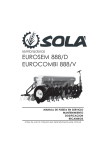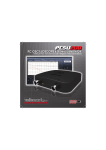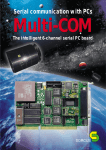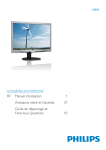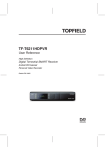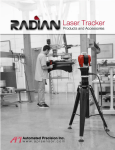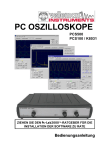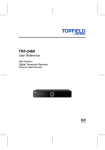Download Intelligent Low-Cost PC Board Intelligent Low-Cost PC Board
Transcript
Data Acquisition, Controlling and Steering with PCs Multi-LAB/2 ® Intelligent Low-Cost PC Board 1 Multi-LAB 2 Intelligent Low-Cost PC Board Apart from many analog and digital inputs and outputs, this board contains – like all SORCUS boards – a processor of its own (’86-compatible). Thus, parallel processing to the PC is possible. This is important especially for modern PC operating systems like Windows and OS/2 in order to achieve real-time capability. Data acquisition, controlling and steering can be run on the board without any interaction with the PC. The PC can perform other tasks, e. g. the graphical display of acquired data. The local RAM on the board can buffer the data until the PC is ready to process them and store them on disk. The board itself is run by a real-time multi-tasking operating system called OsX (the same as on the MO- DULAR-4/486 boards). Thanks to the latest gate array technology, it was possible to put all this on a short PC board. In addition, switches and jumpers could be banished from the board as well as adjustment potentiometers. All settings on the board are carried out by software. The board is available in four versions: MultiLAB/2a, /2d, /2i and /2h. Even though MultiLAB/2i and /2h have the same number of inputs and outputs as the other versions, they offer a higher processing speed of the local CPU, a larger RAM, more analog input and output ranges, a faster A/D-converter and extended digital measuring capabilities, e. g. Special Features ■ Intelligent PC board with its own CPU and memory ■ Parallel processing to the PC ■ Real-time multi-tasking operating system on board ■ 16 analog inputs (12 Bits resolution) ■ 2 analog outputs (12 Bits resolution) TD RD AIN-0 Analog Inputs (12 Bits) RS-232 Interface through AIN-15 RAM ■ 8 digital power outputs, 1 LED ■ 1 timer, 1 universal measuring channel (e. g. for Switch for Card No. NMI DATA IRQ DRQ DAK Analog Outputs (12 Bits) PC Interface I AOUT-OU AOUT-1U AOUT-OI AOUT-1I incremental encoder) ■ 16 digital inputs ■ RS-232-interface for remote debugging CPU x86 Digital Outputs Reset EEPROM U VINA VINB OP-0 ■ Drivers for DOS, through Windows 3.1, Windows 95, OP-7 Windows NT and OS/2 ■ Borland development InterruptController Digital Inputs IP-0 environment can be used through (C++, Pascal) IP-15 LED LED ■ No jumpers or + 12 V – 12 V Watchdog 2 Timer-A Timer-B/Counter Incremental Encoder Interface adjustment potentiometers ■ Short PC board +5V GND ■ Low-cost solution for incremental encoders. In the mode ”Transientenrecorder“ with pre- and post-trigger, a sampling rate of up to 330 kHz can be achieved. The following description refers to Multi-LAB/2h. Please find the differences between the versions in the specifications. Standard Software Multi-LAB/2 is fully supported by the current standard software packages for data acquisition and control, such as ARGUS, DIAdem and DIA/DAGO. Developing Your Own Programs The user can write his/her own real-time programs, which run on the board, e. g. with the help of the Borland development environment for Turbo-Pascal and Borland C++. The Turbo-Debugger incl. remote debugging can be used as well. The board is largely compatible with the MODULAR-4/486 board series. For application programs and data, about 450 KBytes are at the user’s disposal. For the development of PC programs, libraries for Pascal and C++ come with the board. PC Interface The board occupies 8 PC I/O addresses. It can use the PC’s interrupt and DMA channels, everything is configured by software. Several boards can use the same PC interrupt. Counters/Timers to configure e. g. 10 single-ended and 3 differential channels dynamically. What is also controlled by software is the dynamic setting of one of the 16 input ranges for each channel. As a standard, the inputs have an overvoltage protection up to 35 Volts, even when the board is switched off. Customer-Specific Analog Input Ranges When using so-called A-Links (these are micro-modules that can be plugged onto the board), ranges of e. g. 0 to 100 Volts or 4 to 20 mA as well as customer-defined ranges can be provided. Automatic Correction of Analog Input Data The readings are immediately subjected to a digital correction regarding gain and offset. This happens without losing any time by means of a special hardware multiplier and adder in the gate array. The correction values are determined in a correction cycle. During this process, the settle time of the analog input part needed after a channel change is also measured and then always taken into account automatically. Analog Out Analog In The 16 inputs with a resolution of 12 Bits can be operated in the single-ended mode or as differential inputs. The setting is done by software so that there is also the possibility For each of the two channels with a resolution of 12 Bits, two output lines can be used, one for voltage and one for current. The output ranges are switched by software. The outputs have a short-circuit protection. The two counters/ timers are capable of generating local interrupts and can thus be extended as desired. Channel A can be used as a timer, channel B can be operated in other modes as well, e. g. event counter, incremental encoder interface, and for frequency, pulse width or period measurement. Digital In The 16 TTL-compatible digital inputs with Schmitt trigger characteristic can also be operated directly in 24-Volt systems (up to 30 Volts). Digital Out The 8 digital power outputs can switch continuously up to 0.6 A each, both as source and as sink. The maximum switch voltage is 36 Volts. For each group of four channels, it can be supplied from the outside independently. It is also possible to use the +5 V (for TTL-compatibility) or the +12 V of the PC, which are both available at the D-Sub connector. Each output is protected by 2 clamping diodes against inductive voltage peaks. Relays, DC-motors and stepping motors can be connected directly. In case of thermic overload, the outputs are switched off automatically. They can also be switched off by software. 3 A-Links for Multi-LAB/2 A-Links are add-on micro-modules that make it possible to customize the analog input ranges. Test Box Serial Interface The test box is meant for service purposes. It is plugged onto the board’s connector and allows a fully automatic functional test of the board and all its in- and outputs by means of a PC program included in the delivery. With highly precise reference voltages, correction values are determined, which are written automatically into the local EEPROM on the board. For debugging the real-time programs, the Multi-LAB/2i and /2h boards are equipped with a simple serial RS-232-interface. Just link the Multi-LAB/2 board and the PC via a null-modem cable and test and debug your programs with the Borland Turbo-debugger. The Multi-LAB/2i and /2h boards can carry two A-Links, each of which determines the input ranges for 8 analog inputs. The A-Links are independent of each other so a board can be operated with only one or with two different A-Links. One A-Link influences the inputs 0 to 3 and 8 to 11, the other one, the inputs 4 to 7 and 12 to 15. This organization is required because both inputs of a differential channel are changed by the same A-Link. The tables below show which A-Links are currently available. Customer-specific A-Links with other input ranges are possible, too. Please note that the settling characteristics of the Multi-LAB/2 board differ when A-Links are used for voltage inputs. The settle time depends on the type of the A-Link used (see table ‘A-Links for Voltage Inputs’). The Multi-LAB/2 delivery includes: ■ PC board Multi-LAB/2h, /2i, /2d, or /2a ■ User manual (English or German) ■ 78-pin male connector with solder contacts, fitting into the female connector of the board ■ ■ PC libraries and drivers for DOS, Windows and OS/2 ■ On-board library for Borland Pascal and Borland C++ ■ Remote-debugging kernel for Borland TurboDebugger ■ 4 Real-time multi-tasking operating system ‘OsX’ PC program for test and configuration purposes A-Links for Current Inputs A-Link Number/Type Input Input of Inputs Range Impedance 4x20i 4/differential 0 to 20 mA 125 Ω 8x20i 8/single-ended 0 to 20 mA 125 Ω A-Links for Voltage Inputs Voltage Input Max. Input Settle Devider Impedance Range Time 8x10U – 100 kΩ ± 10 V 5 µs 8x20U 1:2 200 kΩ ± 20 V 70 µs 8x40U 1:4 200 kΩ ± 40 V 50 µs 8x100U 1 : 10 200 kΩ ± 100 V 30 µs A-Link Specifications Multi-LAB/2 Multi-LAB Version /2a /2d /2i /2h Unit CPU [1], Clock Memory EEPROM for initialization and adjustment 8 128 no 8 128 no 10 512 yes 16 512 yes MHz KByte PC Interface: PC-I/O-address selectable by software (”plug and play“) PC interrupt channels (channels 3, 5, 9, 10, 11, 12, 15) PC DMA channels (channels 0, 1, 3) Interrupt and DMA channel selectable by software yes yes yes yes yes yes yes yes yes yes yes yes yes yes yes yes – – – – 0/8 12 ±5 no ± 35 > 10 90 10 > 33 16/8 12 ± 10 no ± 35 > 10 90 10 > 33 16/8 12 [3] yes ± 35 > 10 90 2,6 > 71 16/8 12 [3] yes ± 35 > 10 90 1,6 > 111 – bit Volt – Volt MΩ pF µs kHz – no – no 250 yes 330 yes kHz – no no yes yes – 2 12 ±5 ±1 10 10 yes > 20 2 12 ± 10 ±1 10 10 yes > 20 2 12 [4] ±1 10 10 yes > 31 2 12 [4] ±1 10 10 yes > 50 – bit Volt LSB µs mΩ – kHz Serial debug interface (RS-232 asynchronous, 8 data bits, 1 start bit, 1 stop bit, no parity; programmable baud rates: 153600, 38400, 19200, and 9600 baud) no no yes yes – Digital inputs: Number of channels Input range, max. Upper threshold, typ. Lower threshold, typ. Input impedance, typ. All inputs can be sampled simultaneously Min. pulse width for triggering interrupts (IP0, IP1) 16 ± 30 1,9 0,9 3,6 yes 100 16 ± 30 1,9 0,9 3,6 yes 100 16 ± 30 1,9 0,9 3,6 yes 100 16 ± 30 1,9 0,9 3,6 yes 100 – Volt Volt Volt kΩ – ns Timer: Number of channels Timer-A [5]/Timer-B [5], capable of generating interrupts Timer-B programmable for: Timer function, resolution Counter function, max. frequency Frequency measurement, max. frequency Pulse width measurement, resolution Period duration measurement, resolution Incremental encoder interface, max. frequency/phase 2 yes 2 yes 2 yes 2 yes – – 2 – – – – – 2 – – – – – 2 2 2 500 500 1,25 2 3 3 500 500 1,25 µs MHz MHz ns ns MHz Digital outputs [6]: Number of channels External voltag Ux (min./max.) Output level [7]: Low (Ux = 5 V, Io = 20 mA), max. High (Ux = 5 V, Io = – 20 mA), min. Low (Ux = 24 V, Io = 0,6 A), typ. High (Ux = 24 V, Io = – 0,6 A), typ. Output current, continuous, Low/High, max. Peak current (non repetitiv, < 100 µs) Output current (outputs disabled), max. Clamping voltage: High (Io = 0,6 A), typ. Low (Io = – 0,6 A), typ. Slew rate (10% und 90% level), typ. Delay (input to output), pos./neg. slope, typ. 8 5/36 8 5/36 8 5/36 8 5/36 – Volt 0,8 3,2 1,2 Ux – 1,4 ± 0,6 ± 1,2 ± 0,5 0,8 3,2 1,2 Ux – 1,4 ± 0,6 ± 1,2 ± 0,5 0,8 3,2 1,2 Ux – 1,4 ± 0,6 ± 1,2 ± 0,5 0,8 3,2 1,2 Ux – 1,4 ± 0,6 ± 1,2 ± 0,5 Volt Volt Volt Volt A A mA Ux +1,3 – 1,3 300 Ux +1,3 – 1,3 300 Ux +1,3 – 1,3 300 Ux +1,3 – 1,3 300 Volt Volt ns 800/400 800/400 800/400 800/400 ns 95 15 21 0,9 449 0 0 2,3 570 7 0,2 2,9 604 7 0,2 3,1 mA mA mA W Analog inputs: number of channels (single-ended/diff. inputs) Resolution Input ranges Sockets provided for A-Links Overvoltage protection Input impedance (without A-Link) Conversion time Effective sampling rate into lacal RAM Max. sampling rate using mode ”Transientenrecorder” [2] On-board temperature measurement Automatic correction of gain and offset errors Analog outputs: Number of channels Resolution Output ranges Linearity Settle time for full-scale step, typ. Output impedance, typ. Short-circuit protection Effective output rate from local RAM Current drain from PC [8]: + 5 Volt, typ. + 12 Volt, typ. – 12 Volt, typ. Total power dissipation, typ. [8] [1] The CPU is compatible with 80x86 processors. [2] The special mode „Transientenrecorder“ measures continuously into a local ring buffer (64 KBytes) until an external or internal trigger appears. The measurement is ended after a preprogrammed time. Pre- and post-trigger data always amount to 64 KBytes. [3] There is a choice of 16 input ranges (selection by software): Unipolar positive: 0 ... 625 mV, 0 ... 1.25 V, 0 ... 2.5 V, 0 ... 5 V, 0 ... 10 V Unipolar negative: 0 ... -625 mV, 0 ... -1.25 V, 0 ... -2.5 V, 0 ... -5 V, 0 ... -10 V Bipolar: ±312.5 mV, ±625 mV, ±1.25 V, ±2.5 V, ±5 V, ±10 V [4] Each channel provides a voltage output pin and a current output pin. The following ranges can be set for each channel by software: 0 ... 5 V, 0 ... 10 V, ±5 V, ±10 V, 0 ... 20 mA, 4 ... 20 mA. [5] Timer-A is 12 bits wide, Timer-B is 16 bits wide. The length of both timers can be extended by software. [6] The maximum power dissipation for a group of 4 channels (OP0, OP1, OP2, and OP3 or OP4, OP5, OP6, and OP7) is 2 W, e.g.(each channel of a group has a LOW output level): N = 4 * Io * Uo (Io = output current in Ampere, Uo = output voltage in Volts). [7] The outputs are TTLcompatible if Ux = 5 Volts. [8] All inputs and outputs open (not connected). 5 Connection Technology Connection Units, Cables and Connectors for Multi-LAB/2 Table Boxes The connection boxes C1 and C2 serve as a board (except for the LED and the analog either with BNC sockets and screw terminals comfortable connection between the Multi- current outputs of the Multi-LAB/2i and /2h) (C1) or with banana jacks (C2) for connecting LAB/2 board and your measurement devices. are led via a 1.5-m-long shielded round cable the inputs and outputs. For this purpose, all inputs and outputs of the to the connection box, which is provided Connection Boxes C1 and C2 for Multi-LAB/2 INPUT DIGITAL IN CH 0 CH 8 CH 1 CH 9 CH 2 CH 10 CH 3 CH 11 CH 4 CH 12 CH 5 CH 13 CH 6 CH 14 CH 7 CH 15 Connection Box C1 OUTPUT ANALOG IN DIGITAL OUT Dimensions 257 x 168 x 36 mm (length x width x height) 0 1 2 3 4 5 6 7 +12 +5 + 0 1 2 3 8 9 10 11 12 13 14 15 +12 +5 + 4 5 6 7 Cable shielded round cable with 78-pin D-Sub male connector, length 1.5 m Inputs 16 analog inputs via BNC connectors 16 digital inputs via two 8-pin screw terminal blocks ANALOG OUT Outputs 2 analog voltage outputs via a 4-pin screw terminal block 8 digital outputs via two 8-pin screw terminal blocks Vo l t a g e + + 0 1 Supply voltage for external devices +5 V, +12 V via screw terminal block Connection Box C2 INPUT ANALOG SE DI SE DIGITAL DIGITAL Dimensions 257 x 168 x 36 mm (length x width x height) 0 1 2 3 4 5 6 7 0 1 2 3 4 5 6 7 0 1 2 3 4 5 6 7 0 1 2 3 4 5 6 7 8 9 10 11 12 13 14 15 8 9 10 11 12 13 14 15 Inputs 16 single-ended analog inputs via 32 banana jacks or 8 differential analog inputs via banana jacks 16 digital inputs via 32 banana jacks OUTPUT ANALOG V O LT A G E DIGITAL + 12 V U1 U2 V O LTA G E 6 +5V 0 1 2 3 4 5 Cable shielded round cable with 78-pin D-Sub male connector, length 1.5 m 6 7 URef Outputs 2 analog voltage outputs via 4 banana jacks 8 digital outputs via 18 banana jacks Supply voltage for external devices +5 V, +12 V via banana jacks Screw Terminal Block C3 Screw Terminal Block At the screw terminal block, you can access Dimensions the in- and outputs of the Multi-LAB/2 board 86x71x65 (width x depth x height) at 50 screw terminals. All of the in- and outConnection cable puts are at your disposal – except for the LED shielded round cable from 78-pin to output and the analog current outputs of 50-pin D-Sub male connector, length 1.5 m Multi-LAB/2i and /2h. The ground lines of the analog inputs are tied together. The PC’s Inputs 16 single-ended analog inputs supply voltages are not available. The screw via 17 screw terminals or terminal block can be mounted onto all kinds 8 differential analog inputs via of rails that are in accordance with EN 50035 17 screw terminals, 16 digital inputs (G-rail) and EN 50022 (top-hat rail). The con- via 17 screw terminals nection cable is included in the delivery. In Outputs contrast to the cables of the table boxes C1 2 analog voltage outputs via 4 screw and C2, it is not permanently fixed, but plug- terminals, 8 digital outputs via 12 screw ged into a 50-pin D-Sub connector. terminals Screw Terminal Block C3 Multi-LAB/2 Cables and Connectors All inputs and outputs of the Multi-LAB/2 fixing screws) comes with the board. You can other end is open or is provided with a 78-pin board can be accessed via a 78-pin D-Sub acquire additional male connectors and ready- male or female connector. The wires in the female connector. One male connector with made cables with the 78-pin male connector cable are twisted to pairs and, as a whole, solder contacts (including plastic cover and for the Multi-LAB/2 board on one end, the shielded twice. 78-pin male or female connector with plastic coverand fixing screws 78-pin male connector with cable 7 Fax Order Form Adress of customer Company Place, Date Name/Department Name in block letters PO Box/Street Postal Code/City Signature/Stamp Order No. Order No. Quant. Multi-LAB/2 Multi-Function Boards HM-1487 Multi-LAB/2a incl. manual, 78-pin connector and system software HM-1514 Multi-LAB/2d incl. manual, 78-pin connector and system software HM-1488 Multi-LAB/2i incl. manual, 78-pin connector and system software HM-1713 Multi-LAB/2h incl. manual, 78-pin connector and system software Total price Accessories HM-1571 Test box for Multi-LAB/2 incl. software K2-4003 Debugging cable for Multi-LAB/2i and Multi-LAB/2h (3-pin Mini-DIN to 9-pin D-Sub. socket, 1,5 m) FM-1604 Connection Box C1 with BNC-sockets, screw terminals and cable FM-1698 Connection Box C2 with banana jacks and cable FM-1830 Screw-clamp terminal block with screw terminals and cable for Top-hat-rail mounting (50-pin) K1-3078 Round cable with 78-pin male connector, one end open, 1.6 m K2-3078 Round cable with 78-pin male and female connector, 1.6 m K2-3178 Round cable with 7two 8-pin male connectors, 1.6 m FM-1605 78-pin connector with solder contacts with hood FM-1799 78-pin connector with solder contacts with hood A-Links for Analog Inputs for Multi-LAB/2i and /2h FM-1526 20 mA, 4 differential channels FM-1740 20 mA, 8 single-ended channels FM-1877 10 V max., 8 single-ended or 4 differential channels FM-1741 20 V max., 8 single-ended or 4 differential channels FM-1742 40 V max., 8 single-ended or 4 differential channels FM-1744 100 V max., 8 single-ended or 4 differential channels Total Amount Shipping Cost Your Local Distributor: Amount of Invoice Please fill in this order form and fax it or send it by mail. Prices and technical issues are subject to change. SORCUS Computer GmbH, Im Breitspiel 11, D-69126 Heidelberg Phone ++49-6221-32 06-0, Fax ++49-6221-320 6-66, Internet http://www.sorcus.com 8









